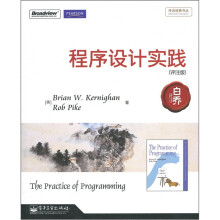前言(新增批注共1条) xii
Chapter 1: Style(新增批注共46条)
1.1 Names
1.2 Expressions and Statements
1.3 Consistency and Idioms
1.4 Function Macros
1.5 Magic Numbers
1.6 Comments
1.7 Why Bother?
Chapter 2: Algorithms and Data Structures(新增批注共29条)
2.1 Searching
2.2 Sorting
2.3 Libraries
2.4 A Java Quicksort
2.5 O-Notation
2.6 Growing Arrays
2.7 Lists
2.8 Trees
2.9 Hash Tables
2.10 Summary
Chapter 3: Design and Implementation(新增批注共12条)
3.1 The Markov Chain Algorithm
3.2 Data Structure Alternatives
3.3 Building the Data Structure in C
3.4 Generating Output
3.5 Java
3.6 C++
3.7 Awk andPerl
3.8 Performance
3.9 Lessons
Chapter 4: Interfaces(新增批注共20条)
4.1 Comma-Separated Values
4.2 A Prototype Library
4.3 A Library for Others
4.4 A C++ Implementation
4.5 Interface Principles
4.6 Resource Management
4.7 Abort, Retry, Fail?
4.8 User Interfaces
Chapter 5: Debugging(新增批注共28条)
5.1 Debuggers
5.2 Good Clues, Easy Bugs
5.3 No Clues, Hard Bugs
5.4 Last Resorts
5.5 Non-reproducible Bugs
5.6 Debugging Tools
5.7 Other People's Bugs
5.8 Summary
Chapter 6: Testing(新增批注共28条)
6.1 Test as You Write the Code
6.2 Systematic Testing
6.3 Test Automation
6.4 Test Scaffolds
6.5 Stress Tests
6.6 Tips for Testing
6.7 Who Does the Testing?
6.8 Testing the Markov Program
6.9 Summary
Chapter 7: Performance(新增批注共30条)
7.1 A Bottleneck
7.4 Tuning the Code
7.5 Space Efficiency
7.6 Estimation
7.7 Summary
Chapter 8: Portability(新增批注共30条)
8.1 Language
8.2 Headers and Libraries
8.3 Program Organization
8.4 Isolation
8.5 Data Exchange
8.6 Byte Order
8.7 Portability and Upgrade
8.8 Internationalization
8.9 Summary
Chapter 9: Notation(新增批注共13条)
9.1 Formatting Data
9.2 Regular Expressions
9.3 Programmable Tools
9.4 Interpreters, Compilers, and Virtual Machines
9.5 Programs that Write Programs
9.6 Using Macros to Generate Code
9.7 Compiling on the Fly
Epilogue
Appendix: Collected Rules
Index








 缺书网
缺书网 扫码进群
扫码进群